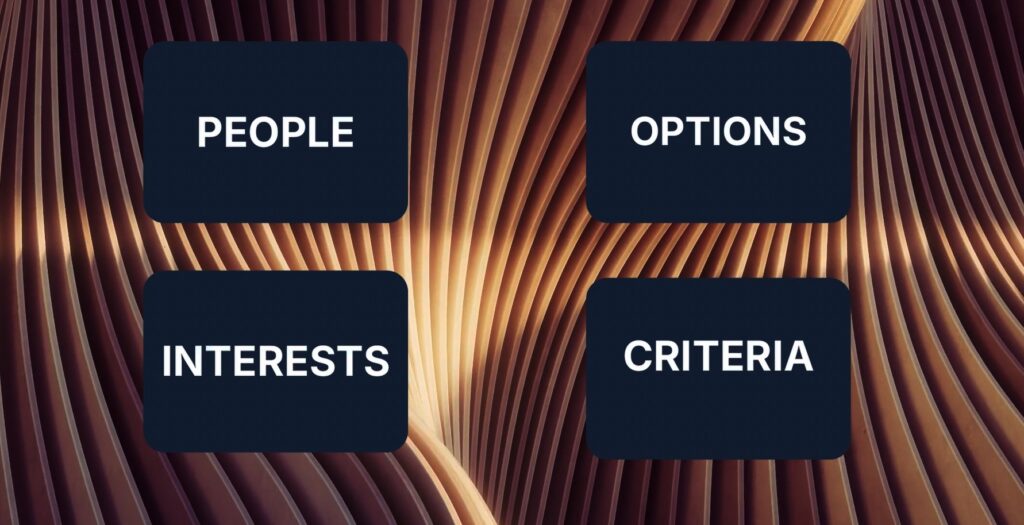Let’s start with what negotiation is…
Simply put, it is a discussion to reach an agreement.
Usually, where people fail at this is something called positional bargaining.
Positional bargaining is where we defend our position no matter what. We turn into this giant rock that is stationary — never going backwards or forwards with the discussion — and this causes the other side to do the same. Things turn into this huge warfare about who is right and why one side is right and not the other.
But before we get into this technique, let’s talk about what an ideal agreement is.
An ideal agreement is where everyone’s interests are taken into consideration and should provide gains for both sides. We should not consider only ourselves and push for an unfavorable outcome for the other party.
So now that we know what outcome we need to achieve, let’s learn the right way to approach any negotiation.
This technique is called principled negotiation.
In principled negotiation, we need to be aware of and work with 4 fundamental points.
Let’s quickly observe what these are and then dive a bit deeper into them:
- People: Separate the people from the problem.
- Interests: Focus on interests, not positions.
- Options: Invent multiple options looking for mutual gains before deciding what to do.
- Criteria: Insist that the result be based on some objective standard.

People: Separate the People from the Problem
As you might have noticed, we are not robots. Everyone has quite a range of emotions, and especially while negotiating, we use the most instinctual ones. Remember fight or flight?
These wild emotions usually will get us into the bad positional bargaining state where we will fight no matter what to protect ourselves and trigger the other side to do the same.

Here is how to deal with this:
- See the situation from the other side’s perspective. Once you use empathy and approach the situation as if BOTH sides are RIGHT, then this will push you into a collaborative state instead of combative. Discuss each other’s perspectives.
- Be explicit about emotions. Remember the thing about humans not being robots? Well, if you do, then good for you — you must have a sharp memory. Anyway, by being open and explicit about your emotions and feelings, you will open up the conversation and cause the other side to be more empathetic. This again turns them from combative to collaborative. Use phrases like, “I feel that we have been silent about this,” or “What do you feel about this proposal?”
- Communicate properly by LISTENING CAREFULLY AND PAYING ATTENTION. Don’t just look at your phone or look around while the other person is speaking. Look into their eyes, nod your head, and be present.
- Clear possible misunderstandings on both sides. Use phrases like, “What do you mean by this specific issue?” or “We are doing this because of this specific situation we are in.”
- Use symbolic gestures. Like offering some nice local desserts or holding the other person’s hands while talking… just kidding, but you know what I mean.
- Even use the space around you. Like sitting on the same side of the table to show that you are here to collaborate.
Interests: Focus on Interests, Not Positions
The second fundamental concept that you need to add to your negotiation toolset is to focus on interests. Defending your position will not help you reach an agreement, but understanding what the other side is interested in will.
This is when you need to put on your thinking hat and analyze: what are our and their interests? Even better, write these down and make a list.
Hell, you can even have a cute tiny little notebook from Temu with your favorite anime on it and pull it out in your negotiation meeting to show the others that Death Note and Attack on Titan are the best animes ever?
Anyway, there will always be conflicting and compatible interests, so why not try to find the compatible ones and reveal the problem at hand?
Once you know the interests, then you can define the problem — and guess what, problems will direct you to the solutions.
Options: Invent Multiple Options Looking for Mutual Gains
Point number 3. Now here is where you need to get a little creative.
After analyzing and compiling the interests, create some solutions. Discuss multiple options and try to find ways to come to an agreement that is good for both sides. Thinking outside the box goes a long way too.
For example, imagine that you are a lawyer buying a car and you are negotiating the price. Don’t tunnel vision into money only. What if there are other things the seller would want — like 5 sessions of legal counsel in exchange for a cheaper deal on the car?
And as you might have guessed, don’t use threats as an option, since by now you are aware of the dangers of positional bargaining and putting the other side in the fight-or-flight situation.

Criteria: Insist That the Result Be Based on Some Objective Standard
And now the last fundamental point: the use of an objective criteria.
If, no matter what you discuss, things are looking grim — you can use this as a last resort to pull the discussion into common ground. You can use objective criteria such as standards, market value, scientific judgment, and many more.
Use these to invite the other side to negotiate for options on a reasonable and logical ground based on facts and data. Find the right criteria and discuss.
What If None of This Works?
What if you tried all of these and nothing works? Oh well, that is life. You cannot always come to an agreement.
But by being aware of, knowing, and practicing these fundamentals, I’m sure you’ll reach better results in your negotiations.
Keep in mind that negotiation is quite difficult — especially because there are many emotions involved — and you might not be able to perform these perfectly when the situation is tense. However, it is a skill that you can improve through practice.
So do read the book Getting to Yes if you have time, since there is a lot more explained in detail. But I do feel that simply knowing these core things will help you be a better negotiator.

